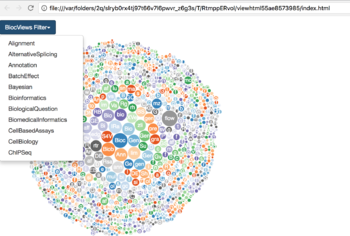Bioconductor: Difference between revisions
| Line 19: | Line 19: | ||
=== From the director of the project === | === From the director of the project === | ||
[https://t.co/rfKF3ABFJp?amp=1 useR 2019] & [https://youtu.be/YEQ5xFewbdA?t=891 youtube] | [https://t.co/rfKF3ABFJp?amp=1 useR 2019] & [https://youtu.be/YEQ5xFewbdA?t=891 youtube] | ||
=== Publications === | |||
https://www.bioconductor.org/help/publications/ | |||
== Mirrors == | == Mirrors == | ||
Revision as of 13:21, 1 November 2019
Project
Release News
Annual reports
http://bioconductor.org/about/annual-reports/
Download stats
- See the overview vignette of BiocPkgTools
- bioconductor.riken.jp mirror in Japan
- biocpkg package in github
From the director of the project
Publications
https://www.bioconductor.org/help/publications/
Mirrors
https://www.bioconductor.org/about/mirrors/
Github mirror
- https://support.bioconductor.org/p/68824/ Announcement (Update: it is dead)
Japan
Package source
Code search
http://search.bioconductor.jp/
BiocManager from CRAN
The reason for using BiocManager instead of biocLite() is mostly to stop sourcing an R script from URL which isn’t so safe. So biocLite() should not be recommended anymore.
It allows to have multiple versions of Bioconductor installed on the same computer. For example, R 3.5 works with Bioconductor 3.7 and 3.8.
On the other hand, setRepositories(ind=1:4) and install.packages() still lets you install Bioconductor packages.
BiocPkgTools
- BiocPkgTools: Collection of simple tools for learning about Bioc Packages]
- https://www.biorxiv.org/content/10.1101/642132v1
BioCExplorer
Explore Bioconductor packages more nicely
source("https://bioconductor.org/biocLite.R")
biocLite("BiocUpgrade")
biocLite("biocViews")
devtools::install_github("seandavi/BiocPkgTools")
devtools::install_github("shians/BioCExplorer")
library(BioCExplorer)
bioc_explore()
BiocViews
- Software
- AssayDomain
- BiologicalQuestion
- Infrastructure
- ResearchField
- StatisticalMethod
- Technology
- WorkflowStep
- AnnotationData
- ChipManufacturer
- ChipName
- CustomArray
- CustomCDF
- CustomDBSchema
- FunctionalAnnotation
- Organism
- PackageType
- SequenceAnnotation
- ExperimentData
- AssayDomainData
- DiseaseModel
- OrganismData
- PackageTypeData
- RepositoryData
- ReproducibleResearch
- SpecimenSource
- TechnologyData
- Workflow
- AnnotationWorkflow
- BasicWorkflow
- DifferentialSplicingWorkflow
- EpigeneticsWorkflow
- GeneExpressionWorkflow
- GenomicVariantsWorkflow
- ImmunoOncologyWorkflow
- ProteomicsWorkflow
- ResourceQueryingWorkflow
- SingleCellWorkflow
Annotation packages
- http://bioconductor.org/help/course-materials/2012/SeattleFeb2012/Annotation.pdf
- https://bioconductor.org/help/course-materials/2017/CSAMA/lectures/1-monday/lecture-04-a-annotation-intro/lecture-04a-annotation-intro.html
- Making and Utilizing TxDb Objects
- Genomic Annotation Resources Introduction to using gene, pathway, gene ontology, homology annotations and the AnnotationHub. Access GO, KEGG, NCBI, Biomart, UCSC, vendor, and other sources.
- AnnotationHub
- OrgDb
- TxDb
- OrganismDb
- BSgenome
- biomaRt
- http://genomicsclass.github.io/book/pages/bioc1_annoCheat.html
- ensembldb package
Gene centric
- AnnotationDbi: Introduction To Bioconductor Annotation Packages
library(hgu133a.db)
library(AnnotationDbi)
k <- head(keys(hgu133a.db, keytype="PROBEID"))
k
# [1] "1007_s_at" "1053_at" "117_at" "121_at" "1255_g_at" "1294_at"
# then call select
select(hgu133a.db, keys=k, columns=c("SYMBOL","GENENAME"), keytype="PROBEID")
# 'select()' returned 1:many mapping between keys and columns
# PROBEID SYMBOL GENENAME
# 1 1007_s_at DDR1 discoidin domain receptor tyrosine kinase 1
# 2 1007_s_at MIR4640 microRNA 4640
# 3 1053_at RFC2 replication factor C subunit 2
# 4 117_at HSPA6 heat shock protein family A (Hsp70) member 6
# 5 121_at PAX8 paired box 8
# 6 1255_g_at GUCA1A guanylate cyclase activator 1A
# 7 1294_at UBA7 ubiquitin like modifier activating enzyme 7
# 8 1294_at MIR5193 microRNA 5193
Genomic centric
Web based
Workflow
Using Bioconductor for Sequence Data
Some packages
Biobase, GEOquery and limma
How to create an ExpressionSet object from scratch? Here we use the code from GEO2R to help to do this task.
library(Biobase)
library(GEOquery)
library(limma)
# Load series and platform data from GEO
gset <- getGEO("GSE32474", GSEMatrix =TRUE, AnnotGPL=TRUE)
if (length(gset) > 1) idx <- grep("GPL570", attr(gset, "names")) else idx <- 1
gset <- gset[[idx]]
# save(gset, file = "~/Downloads/gse32474_gset.rda")
# load("~/Downloads/gse32474_gset.rda")
table(pData(gset)[, "cell line:ch1"])
pData(gset)
# Create an ExpressionSet object from scratch
# We take a shortcut to obtain the pheno data and feature data matrices
# from the output of getGEO()
phenoDat <- new("AnnotatedDataFrame",
data=pData(gset))
featureDat <- new("AnnotatedDataFrame",
data=fData(gset))
exampleSet <- ExpressionSet(assayData=exprs(gset),
phenoData=phenoDat,
featureData=featureDat,
annotation="hgu133plus2")
gset <- exampleSet
# Make proper column names to match toptable
fvarLabels(gset) <- make.names(fvarLabels(gset))
# group names for all samples
gsms <- paste0("00000000111111111XXXXXXXXXXXXXXXXXXXXXXXXXXXXXXXXX",
"XXXXXXXXXXXXXXXXXXXXXXXXXXXXXXXXXXXXXXXXXXXXXXXXXX",
"XXXXXXXXXXXXXXXXXXXXXXXXXXXXXXXXXXXXXXXXXXXXXXXXXX",
"XXXXXXXXXXXXXXXXXXXXXXXX")
sml <- c()
for (i in 1:nchar(gsms)) { sml[i] <- substr(gsms,i,i) }
# Subset an ExpressionSet by eliminating samples marked as "X"
sel <- which(sml != "X")
sml <- sml[sel]
gset <- gset[ ,sel]
# Decide if it is necessary to do a log2 transformation
ex <- exprs(gset)
qx <- as.numeric(quantile(ex, c(0., 0.25, 0.5, 0.75, 0.99, 1.0), na.rm=T))
LogC <- (qx[5] > 100) ||
(qx[6]-qx[1] > 50 && qx[2] > 0) ||
(qx[2] > 0 && qx[2] < 1 && qx[4] > 1 && qx[4] < 2)
if (LogC) { ex[which(ex <= 0)] <- NaN
exprs(gset) <- log2(ex) }
# Set up the data and proceed with analysis
sml <- paste("G", sml, sep="") # set group names
fl <- as.factor(sml)
gset$description <- fl
design <- model.matrix(~ description + 0, gset)
colnames(design) <- levels(fl)
fit <- lmFit(gset, design)
cont.matrix <- makeContrasts(G1-G0, levels=design)
fit2 <- contrasts.fit(fit, cont.matrix)
fit2 <- eBayes(fit2, 0.01)
tT <- topTable(fit2, adjust="fdr", sort.by="B", number=250)
# Display the result with selected columns
tT <- subset(tT, select=c("ID","adj.P.Val","P.Value","t","B","logFC","Gene.symbol","Gene.title"))
tT[1:2, ]
# ID adj.P.Val P.Value t B logFC Gene.symbol
# 209108_at 209108_at 0.08400054 4.438757e-06 6.686977 3.786222 3.949088 TSPAN6
# 204975_at 204975_at 0.08400054 6.036355e-06 6.520775 3.550036 2.919995 EMP2
# Gene.title
# 209108_at tetraspanin 6
# 204975_at epithelial membrane protein 2
Biostrings
- Find the location of a particular sequence. ?vmatchPattern
- https://www.bioconductor.org/help/course-materials/2011/BioC2011/LabStuff/BiostringsBSgenomeOverview.pdf
library(Biostrings)
library(BSgenome.Hsapiens.UCSC.hg19)
vmatchPattern("GCGATCGC", Hsapiens)
plyranges
http://bioconductor.org/packages/devel/bioc/vignettes/plyranges/inst/doc/an-introduction.html
Misc
Package release history
https://support.bioconductor.org/p/69657/
Search the DESCRIPTION file (eg. VariantAnnotation package) in github and the release information can be found there.
